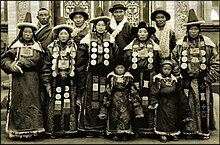Yugur people

|
|
| Total population | |
|---|---|
| (15,000 (est.)) | |
| Regions with significant populations | |
| Sunan Yugur Autonomous County, Gansu, China | |
| Languages | |
| Western Yugur, Eastern Yugur | |
| Religion | |
| Tibetan Buddhism, Tengrism (Turkic Shamanism) | |
| Related ethnic groups | |
| Old Uyghurs, other Turks and Mongols |
The Yugurs (Chinese: 裕固族; pinyin: Yùgù Zú), or Yellow Uyghurs, as they are traditionally known, are one of China's 56 officially recognized nationalities, consisting of 13,719 persons according to the 2000 census. The Yugur live primarily in Sunan Yugur Autonomous County in Gansu, China. They are Tibetan Buddhists.
The nationality's current, official name, Yugur, derived from its autonym: the Turkic-speaking Yugur designate themselves as Yogïr "Yugur" or Sarïg Yogïr "Yellow Yugur", and the Mongolic-speaking Yugur likewise use either Yogor or Šera Yogor "Yellow Yugur". Chinese historical documents have recorded these ethnonyms as Sālǐ Wèiwùr or Xīlǎgǔr. During the Qing dynasty, the Yugur were also called by a term that included "fān", the Classical Chinese term for Tibetic ethnic groups (Chinese: 西喇古兒黃番; pinyin: Xī Lǎgǔr Huáng Fān. In order to distinguish both groups and their languages, Chinese linguists coined the terms Xībù Yùgùr "Western Yugur" and Dōngbù Yùgùr "Eastern Yugur" based on their geographical distribution.
The Turkic-speaking Yugurs are considered to be the descendants of a group of Uyghurs who fled from Mongolia southwards to Gansu after the collapse of the Uyghur Khaganate in 840, where they established the prosperous Gansu Uyghur Kingdom (Ganzhou Uyghur Khanate) (870-1036) with capital near present Zhangye at the base of the Qilian Mountains in the valley of the Ruo Shui. The population of this kingdom, estimated at 300,000 in Song chronicles, practised Manichaeism and Buddhism in numerous temples throughout the country.
...
Wikipedia
